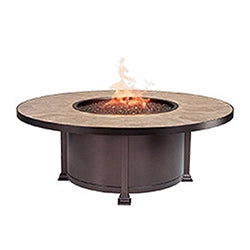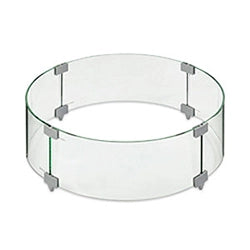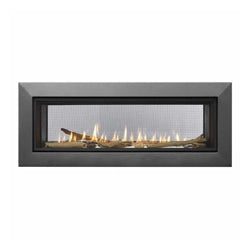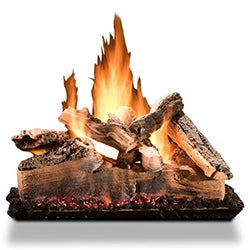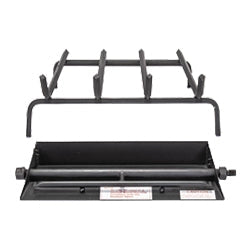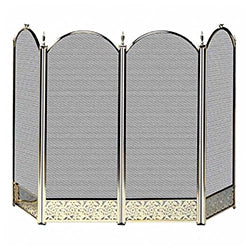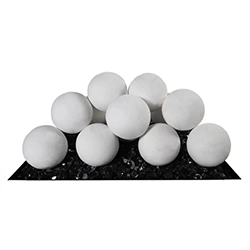Gas logs do a wonderful job at creating a beautiful aesthetic by enhancing the flames in your fireplace. Their benefits include being relatively low maintenance since they don't produce any ash or embers most notably associated with their realistic counterparts, and being manual labor free since they don't need to be chopped, dried, and stock-piled for replenishment. They are overall more cost-effective, which make them great alternatives for real wood burning logs. While gas logs and their corresponding gas burners offer many great benefits, not all are created equal. In this article, we break down the differences between indoor and outdoor gas logs and gas burners so that you can find the one that is right for your needs.
Looking for The Essential Guide to Fireplaces? Read this blog to explore types, benefits, and maintenance tips.
Venting Requirement Basics
 Create the allure of a traditional wood burning fireplace but without the mess of ash and soot with the Vented Royal English Oak Designer Gas Logs by Real Fyre.
Create the allure of a traditional wood burning fireplace but without the mess of ash and soot with the Vented Royal English Oak Designer Gas Logs by Real Fyre.
But first, let's talk about fireplace type. Before installing anything into your home, it's important to understand your state and local building codes as well as what type of fireplace you have as this may determine the type of logs or burners you are permitted to use. Fireplaces, which range from vented, vent-free, and direct-vent just to name a few, may require a specific type of decorative media or burner component that works with their method of installation. For instance, you cannot use logs or burners intended for vented installation inside a vent-free fireplace (we'll get to that more later), so understanding and planning your installation thoughtfully and carefully can go a long way. Once you determine the type of fireplace you have, this makes it easier to narrow down your gas log and gas burner selection.
Looking for the ultimate guide to outdoor fire pit media? Discover how to enhance your backyard experience - read our comprehensive blog post.
But aren't gas logs just gas logs? Not necessarily.
Vented gas logs have more flexibility when it comes to positioning their arrangement since the flames of the fire wrap around the logs. So long as they have adequate ventilation for combustion, of course. These logs are designed more for decorative purposes, rather than heat since most of the heat produced escapes up through the chimney.
Vent-free gas logs, on the other hand, must be stacked and installed in accordance with the manufacturer's instructions as provided in their owner's manual. You will most likely notice gaps in between the log arrangement on a vent-free setup. These gaps serve as air pockets which are required for optimal air flow and proper combustion, so any flame impingement in which the flames touch the logs can result in sooting and poor combustion. One thing to keep in mind with vent-free logs is that they will not produce the same realistic-looking, robust fire as vented gas logs do—but this type of log set is much more heat efficient since the heat generated stays in the room.
For direct vent fireplaces, these sealed combustion systems are tested and certified to be sold as complete units. That means the burner, fireplace media, and fireplace system should be sold altogether. They cannot be modified. No ifs, ands, or buts. So, as mentioned before, not all gas logs are created equal.
How Weather Can Affect Your Gas Log and Burner System
 When using gas logs outdoors, it's highly recommended to pair it with a gas burner made of stainless steel rather than standard steel. Stainless steel gas burners are much more durable for outdoor use as they are much more resistant to rust and corrosion. Real Fyre offers various stainless steel gas burner options that are ideal for outdoor use. (Pictured: Mariposa Vented Fireplace by American Fyre Designs)
When using gas logs outdoors, it's highly recommended to pair it with a gas burner made of stainless steel rather than standard steel. Stainless steel gas burners are much more durable for outdoor use as they are much more resistant to rust and corrosion. Real Fyre offers various stainless steel gas burner options that are ideal for outdoor use. (Pictured: Mariposa Vented Fireplace by American Fyre Designs)
Weather can play a role in your gas log and burner's performance. If using outdoor logs, greater care is involved as they may require more attention. If gas logs—or any fire media for that matter—are exposed to rain or wet conditions, it is imperative the fire media is dry prior to lighting your gas fireplace. Ensuring the fire media is thoroughly and completely dried means moisture doesn't heat up—otherwise the droplets expand and can cause cracking, popping, and damage to your system. Therefore, considering the type of climate your appliance may be exposed to is important when planning for your installation. So, "what should I look for when purchasing outdoor gas logs then?" you may ask.
Look for gas logs made of refractory ceramic and that are colored with heat resistant paint. Although generally a little more expensive, gas logs made of this specialized ceramic and cement mixture have a high heat radiation capability that will make them last for years. Gas logs made of cement, though least expensive, don't radiate as much heat and tend to crack over time. Thus, if you're looking for something with durability that will last you throughout the seasons, invest a little more in refractory ceramic gas logs with a heat resistant paint as this combination will allow the logs to retain their color and stand the test of time.
Can I use my gas logs from my fire pit for my gas fireplace?
No. Gas logs should be installed in accordance with the instructions as provided in the manufacturer's owner's manual. Improper use could void warranties and cause damage to property and life.
While gas logs are mostly commonly made for both indoor and outdoor use, the case is not the same for their gas burner components. Gas logs designed for outdoor use should always be paired with a gas burner system made of stainless steel. Why may you ask? Exposing standard steel to rain and moisture—or even installing it in coastal regions—can cause it to quickly rust and corrode which can affect the functionality of your gas fireplace. Moisture can deteriorate standard steel burners by clogging the burner ports where the gas exits from. Stainless steel gas burners, on the other hand, are preferred for outdoor use because they are much more durable as they have a higher resistance to weathering, which increases your investment's longevity.
It's no wonder why traditionalists prefer the convenience of gas logs and burner systems. They simulate the look of a real wood burning fireplace with the added convenience of eliminating manual labor. No chopping, storage space, or messy cleanup to think about. Keep in mind though that you should always consult with the product owner's manual prior to any installation and hire a professional to install it. But if you're unsure if the gas logs or burner you want are compatible for your living space, you can reach out to our friendly team members. For any additional questions on this subject—or for expert help on any project—feel free to contact our friendly and knowledgeable staff by filling out this simple form. We are here to help.
Main image: Vented Split Oak Designer Plus Gas Logs by Real Fyre







